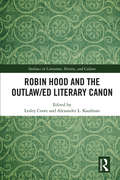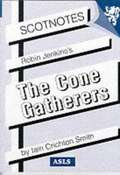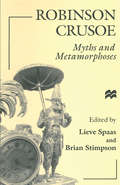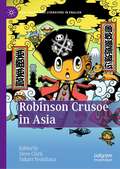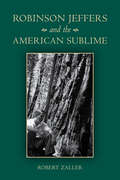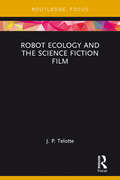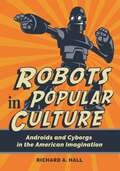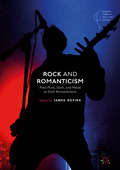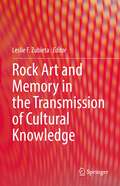- Table View
- List View
Robin Hood and the Outlaw/ed Literary Canon (Outlaws in Literature, History, and Culture)
by Lesley Coote Alexander L. KaufmanThis cutting-edge volume demonstrates both the literary quality and the socio-economic importance of works on "the matter of the greenwood" over a long chronological period. These include drama texts, prose literature and novels (among them, children's literature), and poetry. Whilst some of these are anonymous, others are by acknowledged canonical writers such as William Shakespeare, Ben Jonson, and John Keats. The editors and the contributors argue that it is vitally important to include Robin Hood texts in the canon of English literary works, because of the high quality of many of these texts, and because of their significance in the development of English literature.
Robin Hood and the Outlaw/ed Literary Canon (Outlaws in Literature, History, and Culture)
by Lesley Coote Alexander L. KaufmanThis cutting-edge volume demonstrates both the literary quality and the socio-economic importance of works on "the matter of the greenwood" over a long chronological period. These include drama texts, prose literature and novels (among them, children's literature), and poetry. Whilst some of these are anonymous, others are by acknowledged canonical writers such as William Shakespeare, Ben Jonson, and John Keats. The editors and the contributors argue that it is vitally important to include Robin Hood texts in the canon of English literary works, because of the high quality of many of these texts, and because of their significance in the development of English literature.
Robin Hood in Outlaw/ed Spaces: Media, Performance, and Other New Directions (Outlaws in Literature, History, and Culture)
by Lesley Coote Valerie B. JohnsonFollowing in the tradition of recent work by cultural geographers and historians of maps, this collection examines the apparently familiar figure of Robin Hood as he can be located within spaces that are geographical, cultural, and temporal. The volume is divided into two sections: the first features an interrogation of the literary and other textually transmitted spaces to uncover the critical grounds in which the Robin Hood ’legend’ has traditionally operated. The essays in Part Two take up issues related to performative and experiential space, demonstrating the reciprocal relationship between page, stage, and lived experience. Throughout the volume, the contributors contend with, among other things, modern theories of gender, literary detective work, and the ways in which the settings that once advanced court performances now include digital gaming and the enactment of ’real’ lives.
Robin Hood in Outlaw/ed Spaces: Media, Performance, and Other New Directions (Outlaws in Literature, History, and Culture)
by Lesley Coote Valerie B. JohnsonFollowing in the tradition of recent work by cultural geographers and historians of maps, this collection examines the apparently familiar figure of Robin Hood as he can be located within spaces that are geographical, cultural, and temporal. The volume is divided into two sections: the first features an interrogation of the literary and other textually transmitted spaces to uncover the critical grounds in which the Robin Hood ’legend’ has traditionally operated. The essays in Part Two take up issues related to performative and experiential space, demonstrating the reciprocal relationship between page, stage, and lived experience. Throughout the volume, the contributors contend with, among other things, modern theories of gender, literary detective work, and the ways in which the settings that once advanced court performances now include digital gaming and the enactment of ’real’ lives.
Robin Jenkins's The Cone-Gatherers (Scotnotes Study Guides) (PDF)
by Iain Crichton SmithRobin Jenkins's greatest novel is a powerful examination of good and evil, set against the backdrop of a Scottish estate during World War II. With its themes of class-conflict, war, evil and envy, this is a towering work of fiction that remains as relevant today as when it was first published. Suspenseful, dark and unforgettable, it is one of the masterpieces of modern Scottish literature.
Robinson Crusoe: Myths and Metamorphoses
by Lieve Spaas Brian StimpsonRobinson Crusoe explores Defoe's story, the legend it captured, the universal desire which underlies the myth and a range of modern re-writings which reveal a continued fascination with the problematic character of this narrative. Whether envisaged as an heroic rejection of the old world order, a piece of pre-colonialist propaganda or a tale raising archetypal problems of 'otherness' and 'inequality', the mythic value of Crusoe has become a pretext over many centuries for an examination of some of the fundamental problems of existence. This collection of essays examines, from a wide range of critical and philosophical perspectives, the cultural manifestations of Robinson Crusoe in different centuries, in different media, in different genres.
Robinson Crusoe in Asia (Asia-Pacific and Literature in English)
by Steve Clark Yukari YoshiharaThis collection of essays expands the study of that immensely widely read and much-adapted novel, beyond the first book – The Life and Strange Surprising Adventures of Robinson Crusoe (usually known simply as Robinson Crusoe) – to take in the far less well-known Farther Adventures and the almost unread Serious Reflections, beyond Defoe’s texts, to their re-writing and adaptation and beyond the Atlantic and South American context to an Asian and Pacific context. The essays consider both how Asia is represented in the books (in terms of politics, economics, religion), and how the book has been received, adapted, and taught, particularly in Asian contexts.
Robinson Jeffers and the American Sublime
by Robert ZallerRobinson Jeffers and the American Sublime is the most comprehensive and most substantial critical work ever devoted to the major American poet Robinson Jeffers (1887–1962). Jeffers, the best known poet of California and the American West, particularly valorized the Big Sur region, making it his own as Frost did New England and Faulkner, Mississippi, and connecting it to the wider tradition of the American sublime in Emerson, Thoreau, and John Muir. The book also links Jeffers to a Puritan sublime in early American verse and explores his response to the Darwinian and Freudian revolutions and his engagement with modern astronomy. This discussion leads to a broad consideration of Jeffers' focus on the figure of Christ as emblematic of the human aspiration toward God—a God whom Jeffers defines not in Christian terms but in those of an older materialist pantheism and of modern science. The later sections of the book develop a conspectus of the democratic sublime that addresses American exceptionalism through the prism of Jeffers' Jeffersonian ethos. A final chapter places Jeffers' poetic thought in the larger cosmological perspective he sought in his late works.
Robot Ecology and the Science Fiction Film (Routledge Focus on Film Studies)
by J. P. TelotteThis book offers the first specific application in film studies of what is generally known as ecology theory, shifting attention from history to the (in this case media) environment. It takes the robot as its subject because it has attained a status that resonates not only with some of the key concerns of contemporary culture over the last century, but also with the very nature of film. While the robot has given us a vehicle for exploring issues of gender, race, and a variety of forms of otherness, and increasingly for asking questions about the very nature and meaning of life, this image of an artificial being, typically anthropomorphic, also invariably implicates the cinema’s own and quite fundamental artificing of the human. Looking across genres, across specific media forms, and across closely linked conceptualizations, Telotte sketches a context of interwoven influences and meanings. The result is that this study of the cinematic robot, while mainly focused on science fiction film, also incorporates its appearance in, for example, musicals, cartoons, television, advertising, toys, and literature.
Robot Ecology and the Science Fiction Film (Routledge Focus on Film Studies)
by J. P. TelotteThis book offers the first specific application in film studies of what is generally known as ecology theory, shifting attention from history to the (in this case media) environment. It takes the robot as its subject because it has attained a status that resonates not only with some of the key concerns of contemporary culture over the last century, but also with the very nature of film. While the robot has given us a vehicle for exploring issues of gender, race, and a variety of forms of otherness, and increasingly for asking questions about the very nature and meaning of life, this image of an artificial being, typically anthropomorphic, also invariably implicates the cinema’s own and quite fundamental artificing of the human. Looking across genres, across specific media forms, and across closely linked conceptualizations, Telotte sketches a context of interwoven influences and meanings. The result is that this study of the cinematic robot, while mainly focused on science fiction film, also incorporates its appearance in, for example, musicals, cartoons, television, advertising, toys, and literature.
Robots and Communication
by E. SandryThis book explores communication between humans and robots. Using a range of communication theories, it highlights how each theory provides a different perspective on the communication that occurs. The analysis of human interactions with a variety of forms of robot suggests new ways to perceive what communication, and being a communicator, entails.
Robots in Popular Culture: Androids and Cyborgs in the American Imagination
by Richard A. HallRobots in Popular Culture: Androids and Cyborgs in the American Imagination seeks to provide one go-to reference for the study of the most popular and iconic robots in American popular culture.In the last 10 years, technology and artificial intelligence (AI) have become not only a daily but a minute-by-minute part of American life—more integrated into our lives than anyone would have believed even a generation before. Americans have long known the adorable and helpful R2-D2 and the terrible possibilities of Skynet and its army of Terminators. Throughout, we have seen machines as valuable allies and horrifying enemies. Today, Americans cling to their mobile phones with the same affection that Luke Skywalker felt for the squat R2-D2. Meanwhile, our phones, personal computers, and cars have attained the ability to know and learn everything about us.This volume opens with essays about robots in popular culture, followed by 100 A–Z entries on the most famous AIs in film, comics, and more. Sidebars highlight ancillary points of interest, such as authors, creators, and tropes that illuminate the motives of various robots. The volume closes with a glossary of key terms and a bibliography providing students with resources to continue their study of what robots tell us about ourselves.
Robots in Popular Culture: Androids and Cyborgs in the American Imagination
by Richard A. HallRobots in Popular Culture: Androids and Cyborgs in the American Imagination seeks to provide one go-to reference for the study of the most popular and iconic robots in American popular culture.In the last 10 years, technology and artificial intelligence (AI) have become not only a daily but a minute-by-minute part of American life—more integrated into our lives than anyone would have believed even a generation before. Americans have long known the adorable and helpful R2-D2 and the terrible possibilities of Skynet and its army of Terminators. Throughout, we have seen machines as valuable allies and horrifying enemies. Today, Americans cling to their mobile phones with the same affection that Luke Skywalker felt for the squat R2-D2. Meanwhile, our phones, personal computers, and cars have attained the ability to know and learn everything about us.This volume opens with essays about robots in popular culture, followed by 100 A–Z entries on the most famous AIs in film, comics, and more. Sidebars highlight ancillary points of interest, such as authors, creators, and tropes that illuminate the motives of various robots. The volume closes with a glossary of key terms and a bibliography providing students with resources to continue their study of what robots tell us about ourselves.
Robust Emotion Recognition using Spectral and Prosodic Features (SpringerBriefs in Speech Technology)
by K. Sreenivasa Rao Shashidhar G. KoolagudiIn this brief, the authors discuss recently explored spectral (sub-segmental and pitch synchronous) and prosodic (global and local features at word and syllable levels in different parts of the utterance) features for discerning emotions in a robust manner. The authors also delve into the complementary evidences obtained from excitation source, vocal tract system and prosodic features for the purpose of enhancing emotion recognition performance. Features based on speaking rate characteristics are explored with the help of multi-stage and hybrid models for further improving emotion recognition performance. Proposed spectral and prosodic features are evaluated on real life emotional speech corpus.
Robust Speech Recognition of Uncertain or Missing Data: Theory and Applications
by Dorothea Kolossa Reinhold Haeb-UmbachAutomatic speech recognition suffers from a lack of robustness with respect to noise, reverberation and interfering speech. The growing field of speech recognition in the presence of missing or uncertain input data seeks to ameliorate those problems by using not only a preprocessed speech signal but also an estimate of its reliability to selectively focus on those segments and features that are most reliable for recognition. This book presents the state of the art in recognition in the presence of uncertainty, offering examples that utilize uncertainty information for noise robustness, reverberation robustness, simultaneous recognition of multiple speech signals, and audiovisual speech recognition.The book is appropriate for scientists and researchers in the field of speech recognition who will find an overview of the state of the art in robust speech recognition, professionals working in speech recognition who will find strategies for improving recognition results in various conditions of mismatch, and lecturers of advanced courses on speech processing or speech recognition who will find a reference and a comprehensive introduction to the field. The book assumes an understanding of the fundamentals of speech recognition using Hidden Markov Models.
Robustness in Language and Speech Technology (Text, Speech and Language Technology #17)
by Jean-Claude Junqua Gertjan Van NoordIn this book we address robustness issues at the speech recognition and natural language parsing levels, with a focus on feature extraction and noise robust recognition, adaptive systems, language modeling, parsing, and natural language understanding. This book attempts to give a clear overview of the main technologies used in language and speech processing, along with an extensive bibliography to enable topics of interest to be pursued further. It also brings together speech and language technologies often considered separately. Robustness in Language and Speech Technology serves as a valuable reference and although not intended as a formal university textbook, contains some material that can be used for a course at the graduate or undergraduate level.
Robustness-Related Issues in Speaker Recognition (SpringerBriefs in Electrical and Computer Engineering)
by Thomas Fang Zheng Lantian LiThis book presents an overview of speaker recognition technologies with an emphasis on dealing with robustness issues. Firstly, the book gives an overview of speaker recognition, such as the basic system framework, categories under different criteria, performance evaluation and its development history. Secondly, with regard to robustness issues, the book presents three categories, including environment-related issues, speaker-related issues and application-oriented issues. For each category, the book describes the current hot topics, existing technologies, and potential research focuses in the future. The book is a useful reference book and self-learning guide for early researchers working in the field of robust speech recognition.
Roc the Mic Right: The Language of Hip Hop Culture
by H. Samy AlimComplementing a burgeoning area of interest and academic study, Roc the Mic Right explores the central role of language within the Hip Hop Nation (HHN). With its status convincingly argued as the best means by which to read Hip Hop culture, H. Samy Alim then focuses on discursive practices, such as narrative sequencing and ciphers, or lyrical circles of rhymers. Often a marginalized phenomenon, the complexity and creativity of Hip Hop lyrical production is emphasised, whilst Alim works towards the creation of a schema by which to understand its aesthetic. Using his own ethnographic research, Alim shows how Hip Hop language could be used in an educational context and presents a new approach to the study of the language and culture of the Hip Hop Nation: 'Hiphopography'. The final section of the book, which includes real conversational narratives from Hip Hop artists such as The Wu-Tang Clan and Chuck D, focuses on direct engagement with the language. A highly accessible and lively work on the most studied and read about language variety in the United States, this book will appeal not only to language and linguistics researchers and students, but holds a genuine appeal to anyone interested in Hip Hop or Black African Language.
Roc the Mic Right: The Language of Hip Hop Culture
by H. Samy AlimComplementing a burgeoning area of interest and academic study, Roc the Mic Right explores the central role of language within the Hip Hop Nation (HHN). With its status convincingly argued as the best means by which to read Hip Hop culture, H. Samy Alim then focuses on discursive practices, such as narrative sequencing and ciphers, or lyrical circles of rhymers. Often a marginalized phenomenon, the complexity and creativity of Hip Hop lyrical production is emphasised, whilst Alim works towards the creation of a schema by which to understand its aesthetic. Using his own ethnographic research, Alim shows how Hip Hop language could be used in an educational context and presents a new approach to the study of the language and culture of the Hip Hop Nation: 'Hiphopography'. The final section of the book, which includes real conversational narratives from Hip Hop artists such as The Wu-Tang Clan and Chuck D, focuses on direct engagement with the language. A highly accessible and lively work on the most studied and read about language variety in the United States, this book will appeal not only to language and linguistics researchers and students, but holds a genuine appeal to anyone interested in Hip Hop or Black African Language.
Rochester and the pursuit of pleasure
by Larry D CarverRochester and the pursuit of pleasure provides a reading of Rochester’s poems, dramatic works, and letters in a biographical context. In doing so, it sheds light on a central vexed issue in Rochester criticism, the relationship of the poet to his speaker. It also reveals that Rochester’s work clusters about a central theme, the pursuit of pleasure, a pursuit motivated by a courtship of purity that grew out of Rochester’s Christian and God-fearing upbringing. This rhetoric of courtship, in turn, reveals the unity of Rochester’s work as the courtier and his various personae try to persuade his audiences, secular and divine, of his worth.
Rochester and the pursuit of pleasure
by Larry D CarverRochester and the pursuit of pleasure provides a reading of Rochester’s poems, dramatic works, and letters in a biographical context. In doing so, it sheds light on a central vexed issue in Rochester criticism, the relationship of the poet to his speaker. It also reveals that Rochester’s work clusters about a central theme, the pursuit of pleasure, a pursuit motivated by a courtship of purity that grew out of Rochester’s Christian and God-fearing upbringing. This rhetoric of courtship, in turn, reveals the unity of Rochester’s work as the courtier and his various personae try to persuade his audiences, secular and divine, of his worth.
Rock and Romanticism: Post-Punk, Goth, and Metal as Dark Romanticisms (Palgrave Studies in Music and Literature)
by James RoviraRock and Romanticism: Post-Punk, Goth, and Metal as Dark Romanticisms explores the relationships among the musical genres of post-punk, goth, and metal and American and European Romanticisms traditionally understood. It argues that these contemporary forms of music are not only influenced by but are an expression of Romanticism continuous with their eighteenth- and nineteenth-century influences. Figures such as Blake, Wordsworth, Coleridge, Byron, Keats, Mary Shelley, Percy Shelley, Friedrich, Schlegel, and Hoffman are brought alongside the music and visual aesthetics of the Rolling Stones, the New Romantics, the Pretenders, Joy Division, Nick Cave, Tom Verlaine, emo, Eminem, My Dying Bride, and Norwegian black metal to explore the ways that Romanticism continues into the present in all of its varying forms and expressions.
Rock and Romanticism: Post-Punk, Goth, and Metal as Dark Romanticisms (Palgrave Studies in Music and Literature)
by James RoviraRock and Romanticism: Post-Punk, Goth, and Metal as Dark Romanticisms explores the relationships among the musical genres of post-punk, goth, and metal and American and European Romanticisms traditionally understood. It argues that these contemporary forms of music are not only influenced by but are an expression of Romanticism continuous with their eighteenth- and nineteenth-century influences. Figures such as Blake, Wordsworth, Coleridge, Byron, Keats, Mary Shelley, Percy Shelley, Friedrich, Schlegel, and Hoffman are brought alongside the music and visual aesthetics of the Rolling Stones, the New Romantics, the Pretenders, Joy Division, Nick Cave, Tom Verlaine, emo, Eminem, My Dying Bride, and Norwegian black metal to explore the ways that Romanticism continues into the present in all of its varying forms and expressions.
Rock Art and Memory in the Transmission of Cultural Knowledge
by Leslie F. ZubietaThis book shares timely and thought-provoking methodological and theoretical approaches from perspectives concerning landscape, gender, cognition, neural networks, material culture and ontology in order to comprehend rock art’s role in memorisation processes, collective memory, and the intergenerational circulation of knowledge. The case studies offered here stem from human experiences from around the globe—Africa, Australia, Europe, North and South America—, which reflects the authors’ diverse interpretative stances. While some of the approaches deal with mnemonics, new digital technologies and statistical analysis, others examine performances, sensory engagement, language, and political disputes, giving the reader a comprehensive view of the myriad connections between memory studies and rock art. Indigenous interlocutors participate as collaborators and authors, creating space for Indigenous narratives of memory. These narratives merge with Western versions of past and recent memories in order to construct jointly novel inter-epistemic understandings of images made on rock. Each chapter demonstrates the commitment of rock art studies to strengthen and enrich the field by exploring how communities and cultures across time have perceived and entangled rock images with a broad range of material culture, nonhumans, people, emotions, performances, sounds and narratives. Such relations are pivotal to understanding the universe behind the intersections of memory and rock art and to generating future interdisciplinary collaborative studies.
Rock Your Presentation: A New Guide to Speaking with Passion
by Nigel BarlowThis book will protect your audiences from the following disorders:· Death by PowerPoint· Tedium· Compulsive fidgeting· Losing-the-Will-to-Live SyndromeNearly all of us have to pitch or present our ideas, whether in a formal setting like a theatre, at a company conference, in a classroom or even selling a concept one-to-one to our boss. In Rock your Presentation, Nigel Barlow, a professional keynote speaker and creative coach to many of the world's most famous organisations, gives you inspiring insights and practical techniques to 'rock up' your presentation or speech. Many of these tips come from exploring what makes great music so moving and impactful, and are easy to apply to make your own talks more dynamic and memorable. Try changing your key for different emotional impact; come up with a stronger chorus and an exciting climax; create your speaker's rider; be a protest singer to unleash your passion; and learn when and how to go unplugged to touch your audience. Whether you want to create a whole new presentation or tune up a tired old one, Rock Your Presentation will give you plenty of fresh ideas.
